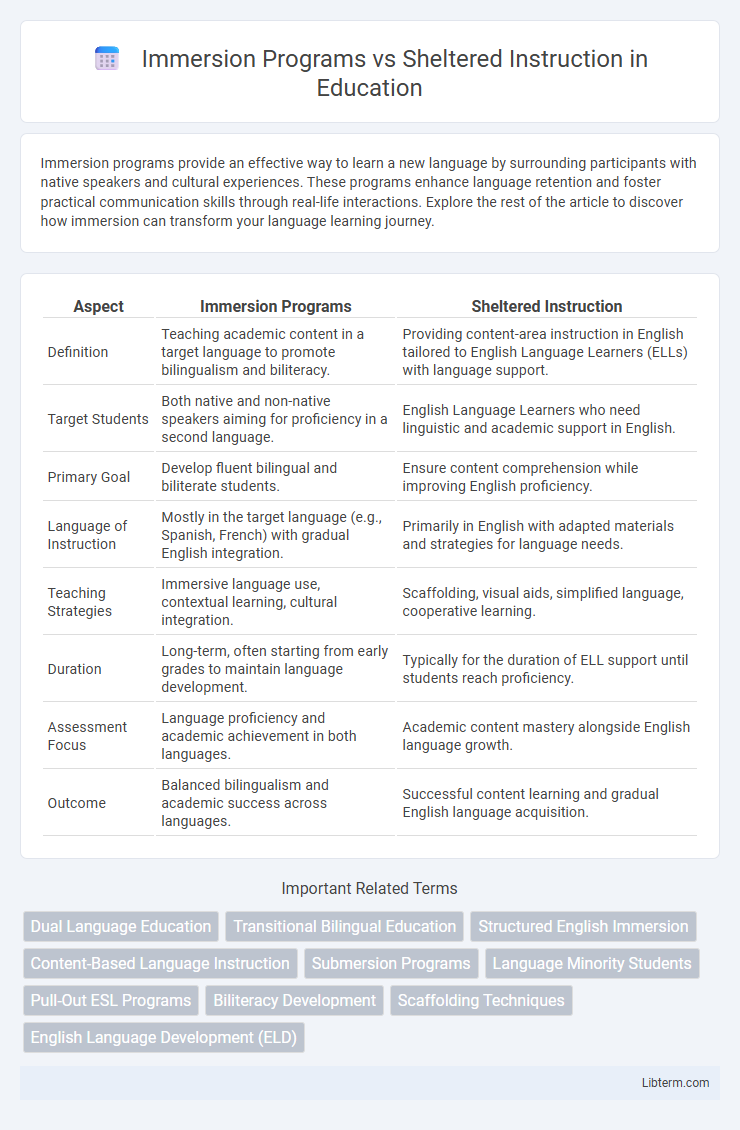Immersion programs provide an effective way to learn a new language by surrounding participants with native speakers and cultural experiences. These programs enhance language retention and foster practical communication skills through real-life interactions. Explore the rest of the article to discover how immersion can transform your language learning journey.
Table of Comparison
| Aspect | Immersion Programs | Sheltered Instruction |
|---|---|---|
| Definition | Teaching academic content in a target language to promote bilingualism and biliteracy. | Providing content-area instruction in English tailored to English Language Learners (ELLs) with language support. |
| Target Students | Both native and non-native speakers aiming for proficiency in a second language. | English Language Learners who need linguistic and academic support in English. |
| Primary Goal | Develop fluent bilingual and biliterate students. | Ensure content comprehension while improving English proficiency. |
| Language of Instruction | Mostly in the target language (e.g., Spanish, French) with gradual English integration. | Primarily in English with adapted materials and strategies for language needs. |
| Teaching Strategies | Immersive language use, contextual learning, cultural integration. | Scaffolding, visual aids, simplified language, cooperative learning. |
| Duration | Long-term, often starting from early grades to maintain language development. | Typically for the duration of ELL support until students reach proficiency. |
| Assessment Focus | Language proficiency and academic achievement in both languages. | Academic content mastery alongside English language growth. |
| Outcome | Balanced bilingualism and academic success across languages. | Successful content learning and gradual English language acquisition. |
Introduction: Understanding Bilingual Education Approaches
Immersion programs immerse students in a second language by using it as the primary medium of instruction to promote fluency and content mastery simultaneously. Sheltered instruction adapts content teaching by integrating language support strategies to help English learners access grade-level material effectively. Both approaches aim to develop bilingual proficiency but differ in instructional focus and language use within the classroom.
Defining Immersion Programs
Immersion programs are educational approaches where students are taught curriculum content in a second language for a significant portion of the day, fostering bilingualism and academic achievement. These programs emphasize language acquisition through meaningful interaction with native speaker instructors and culturally rich materials. Immersion differs from sheltered instruction by prioritizing language immersion over simplified content delivery in the second language.
Overview of Sheltered Instruction
Sheltered instruction is an educational approach designed to make academic content understandable for English Language Learners by integrating language development with subject matter teaching. This method uses strategies such as visual aids, modeling, and scaffolding to support comprehension while promoting English proficiency. Sheltered instruction is commonly implemented in mainstream classrooms to help students acquire both subject knowledge and language skills simultaneously.
Key Goals and Philosophies
Immersion programs emphasize complete language exposure by teaching academic content entirely in the target language to promote fluency and cultural competence. Sheltered instruction aims to make subject matter comprehensible for English language learners by using strategies like visual aids and scaffolding while supporting language development. Both approaches prioritize language acquisition but differ in balancing content mastery and linguistic accessibility.
Curriculum Design and Language Use
Immersion programs integrate language learning with grade-level content through a curriculum designed to promote fluency by using the target language as the medium of instruction. Sheltered instruction tailors content delivery by modifying language complexity and employing scaffolding techniques, focusing on making academic content comprehensible while supporting English language development. Curriculum design in immersion emphasizes full language immersion and cognitive engagement, whereas sheltered instruction balances content mastery with language accessibility for English learners.
Teaching Strategies and Methodologies
Immersion programs utilize content-based language instruction where students learn subjects like math and science through the target language, promoting natural language acquisition and cognitive engagement. Sheltered instruction employs strategies such as scaffolding, visual aids, and modified speech to make academic content accessible while developing language proficiency simultaneously. Both methodologies emphasize interactive, student-centered learning but differ in language emphasis, with immersion focusing on full language use and sheltered instruction balancing language support with content mastery.
Student Demographics and Placement
Immersion programs typically serve students from diverse linguistic backgrounds aiming for bilingual or multilingual proficiency, often placed in classrooms where instruction is primarily in the target language alongside content integration. Sheltered instruction targets English Language Learners (ELLs) who need support to access grade-level content while developing English skills, with placements in mainstream classrooms supplemented by tailored language support. Both approaches consider language proficiency, academic needs, and cultural background to optimize student engagement and learning outcomes.
Academic Outcomes and Language Proficiency
Immersion programs significantly enhance academic outcomes by integrating language development with content instruction, resulting in higher proficiency in both the target language and academic subjects. Sheltered instruction supports language learners by simplifying content and using visual aids, which improves comprehension but may limit advanced language fluency and academic achievement compared to immersion. Research consistently shows immersion students outperform their sheltered instruction peers in standardized tests and language proficiency assessments, highlighting immersion's effectiveness in dual-language acquisition and academic success.
Advantages and Challenges of Each Approach
Immersion programs enhance language acquisition through full cognitive engagement in the target language, promoting fluency and cultural competence, but may challenge students with limited prior language exposure or academic background. Sheltered instruction supports content comprehension by integrating language objectives with subject matter, benefiting English learners through scaffolding and contextualized vocabulary, yet it requires specialized teacher training and may slow content coverage. Both approaches balance language development with academic achievement, demanding tailored implementation to meet diverse learner needs effectively.
Choosing the Right Model for Learner Success
Immersion programs promote bilingual proficiency by integrating content and language learning in a cohesive environment, enhancing cognitive skills and cultural awareness. Sheltered instruction focuses on adapting academic content to meet the linguistic needs of English Language Learners (ELLs), ensuring comprehension and meaningful participation in mainstream classrooms. Selecting the appropriate model depends on learners' language proficiency levels, educational goals, and available resources to maximize language acquisition and academic success.
Immersion Programs Infographic

 libterm.com
libterm.com